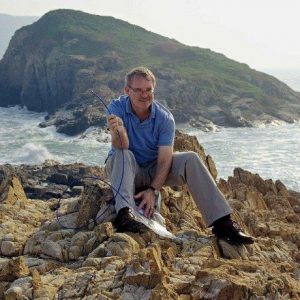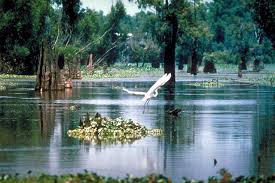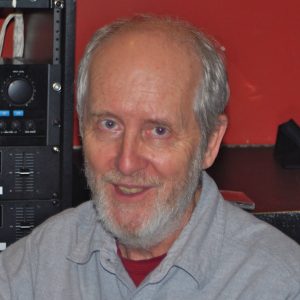More dangerous warming methane is pouring into the atmosphere. Later in this hour, UK scientist Euan Nisbet tells us where it is coming from, and no, not from the Arctic. First the visionary scientist Thomas Crowther from ETH Zurich on carbon, warming, the Arctic, and a plan to plant a trillion trees to help stabilize the climate. Yes we can – and the kids have already started.
Listen to or download this Radio Ecoshock show in CD Quality (57 MB) or Lo-Fi (14 MB)
CARBON FROM SOIL AND TREES: CURSE OR CURE? THOMAS CROWTHER
There is far more carbon stored in soil of planet Earth than in it’s atmosphere. If soil organisms release that carbon as carbon dioxide, faster as the climate warms, we may not be able to stop it. Or can we? Our guest Dr. Thomas Crowther is an assistant professor of Global Ecosystem Ecology at ETH Zurich. He directs the Crowther Lab. Thomas is also a Marie Curie Fellow at the Netherlands Institute of Ecology. Our last interview on Radio Ecoshock was in December 2016, and he’s been busy since then. If you care about life, this is a must-listen guest.
Listen to or download my 29 minute interview with Thomas Crowther in CD Quality or Lo-Fi
At the 2019 Annual meeting of the American Academy for the Advancement of Science in Washington this February, Thomas presented a chart showing WHERE carbon is buried under the soil. The biggest depository of carbon in the soil is a surprise. There more carbon held in the Arctic, than in plant-rich places like the Tropics.
Yes growth in tropical rainforests is lush, with massive amounts of carbon held in plants. But warmer temperatures and adequate water in the soil means bacteria is rich, and the tropical soil is actually poor in carbon. By contrast, there is less plant production each year in the Arctic, but in the cold or even frozen soil, very little plant residue is processed in the soil. That carbon builds up over thousands of years, becoming a huge storehouse – unless the soil is warmed, as it is now.
Increasing carbon loss from the Arctic adds to the greenhouse effect, thus creating a positive feedback loop heating the planet even more. Crowther’s team research found warming of the world’s Arctic and sub-Arctic regions is causing the release of soil carbon, and that could accelerate climate change by 17 percent by 2050.
The first global map of life under the soil has been developed by the Crowther Lab. He also tells us about the Global Soil Biodiversity Initiative.
Check out this article: “Losses of soil carbon under global warming might equal US emissions” November 30, 2016, Yale University.
In another interview, Crowther says: “there are probably more animals in the Arctic than the Tropics”. That is mind-blowing. He is counting as animals tiny creatures like nematode worms in the soil.
COUNTING TREES
Our second adventure into Crowther’s projects starts by asking how many trees there are on Earth. Until he tackled this, getting that number seemed impossible. His techniques involved calling in records from foresters all over the world, plus satellite data and other information (including soil productivity) – to model out the total. He found previous estimates were way too low. There are about 3.04 trillion trees on Earth! Trees on Earth may be comparable in number to stars in our galaxy.
The better news is: he finds we could grow an another 1.2 trillion new trees. These could be planted without having to give up croplands or city space to do it. The United Nations has a program aiming to plant a trillion trees. If that is successful, those trees could capture enough carbon to reduce our exposure to extreme climate change. Tree planting cannot totally save us, but it can play a huge role. It is hard to imagine any other way to capture enough carbon to matter.
To find out more, look up the Plant-for-the-Planet Initiative. There Trillion Tree Campaign is featured in this YouTube video.
Beyond the global soil data we talked about, The Crowther lab is launching a second giant pool of data for use by the international community. It is called “the Global Forest Biodiversity Initiative“.
When I watch a couple of Crowther’s YouTube video presentations, I’m stunned by the brand new maps of where things grow on our planet, or life we’ve never seen, hidden underground. We expect experts to use GIS – Geographic Information Systems – to communicate complex results. But now scientists can also use those maps as tools of discovery, to find new things.
And watch the background in this video, to get a sample of the cool new maps created by the Crowther Lab. This is a YouTube video recorded at an ESRI conference, the GIS people, published on Jul 10, 2018.
And this interview published Jan 2, 2019 on how ETH Zurich uses GIS. Great images in both videos, worth capturing…
THE 2016 APPEARANCE OF THOMAS CROWTHER ON RADIO ECOSHOCK
You can catch up on Thomas Crowther’s important earlier work with this Radio Ecoshock show (blog here).
Find this scientific paper “Quantifying global soil carbon losses in response to warming” abstract here, or here in the full text.
The key conclusion says scientists have found “empirical support” that rising temperature can stimulate carbon loss from the soil that “could accelerate planetary warming over the twenty-first century.”
As our guest points out, this large feedback has been left out of the large-scale models that create projections of warming. That means experts advising governments, and the Intergovernmental Panel on Climate Change, have lower estimates of developing global warming than reality.
A Eureka Alert piece on the 2016 science here.
=============================================================================================
STRANGE SOURCE FOR THE NEW METHANE BURST: EUAN NISBET
Next up, some surprises from the scientist who first warned us about Arctic methane, where it’s coming from now, and why this little-publicized gas could derail the Paris Agreement to save a livable climate.
Listen to or download my 29 minute interview with Euan Nisbet in CD Quality or Lo-Fi
Levels of the strong warming gas methane are again rising in the atmosphere. A new study warns that trend could derail plans made at Paris to contain climate change. Is the new surge of methane coming from the Arctic? Is it from fracking and natural gas pipelines? Guess again.
Our next guest investigated the new mystery methane surge. Professor Euan Nisbet is a Professor of Earth Sciences at the Royal Holloway, University of London. On February 5, 2019 the American Geophysical Union published the paper “Very strong atmospheric methane growth in the four years 2014-2017: Implications for the Paris Agreement.” The lead author is Euan Nisbet.

Dr. Euan Nisbet, atmospheric scientist UK
For more than a decade, I interviewed at least a dozen scientists about methane as a threat to our common future. Most talked about methane from the Arctic. Some non-scientist bloggers suggest Arctic methane will end in catastrophe. It might tip us into extinction they say.
Other scientists on this show explained their studies into methane in the skies over natural gas fracking, pipelines and storage facilities. Only one, David Archer from the University of Chicago, in 2012, pointed us away from those sources, and toward tropical peat lands.
When I started this radio program in 2006, scientists told us the methane burden in the atmosphere was either paused, or growing very slowly. But in 2007 that burden, measured in parts per billion in the atmosphere, began to climb again. In the last four years though, atmospheric methane is increasing much more rapidly. I will call it a “spurt” of dangerous methane. Euan Nisbet took on the task of finding out where that new burden of gas is coming from.
According to the U.S. National Atmospheric and Oceanic Administration, in October 2018, a year after the study boundary for Nisbet’s new paper, methane was 1867.6 parts per billion, up from 1851.1 the previous October (2017)[NOAA] So it is still going up.
Until about 1750, the presumed start of the industrial era, methane levels since the year 1000 hovered below 700 ppb. They have far more than doubled, with an extremely steep rise going more vertical starting around 1950. That comes from this online chart of atmospheric methane from pre-industrial to very recent readings.
HOW THEY KNOW
Euan tells us he began tracking methane while working as a scientist in Canada. He was among the first to warn about the risk of thawing permafrost producing methane, and “clathrates” – frozen methane in the sea or sea bed. No one can accuse Nisbet of ignoring the risk of Arctic methane.
But Nisbet is in a lab that is central to measuring the composition of the atmosphere. There is a careful technique to capture air in flasks, which can be shipped to the atmospheric lab at Royal Holloway in London. Analyzing that air, scientists can determine the amount of different elements, molecules, and particles. When they find more methane in a flask in 2016, than in 2014 or 2010, Nisbet also knows where that flask came from.
OFF TO AFRICA
The flasks with the most increasing methane come from a vast lake and bog land in East Africa, in Zambia and Uganda. The Nisbet team arranged a series of aircraft flights over both countries to capture more air samples. Those were returned to England for analysis.

Lake Bangweulu, East Africa
We’ve heard so much about methane from the Arctic, and from natural gas systems. Most of us have never seen a tropical peat bog, and have no idea they operate. There is so much water in one system, including more than a dozen rivers, one of Africa’s giant shallow lakes, and tropical peat bogs. There is also a massive production of carbon in vegetation annually, and a vast amount of vegetative matter active under the water. Decomposition in the wet leads to more methane relative to carbon dioxide emitted in land decomposition.
From measuring the amount of isotopes of methane, scientists know this is “biogenic” methane. It comes from organisms in the soil, rather than the natural gas industry (for example).
The Nisbet-led paper says: “Bacteria that consume carbon and produce methane in wetlands, for instance, tend to take up more of the lighter carbon-12 isotope. Fossil-fuel operations tend to release methane that contains more of the heavier carbon-13 isotope. Methane produced in a fire falls somewhere in between.”
METHANE FROM FOSSIL FUEL PRODUCTION
A Letter in Nature published in October 2016, led by Stefan Schwietzke of NOAA, also analyzed methane isotopes. They found, quote: “that total fossil fuel methane emissions (fossil fuel industry plus natural geological seepage) are not increasing over time, but are 60 to 110 per cent greater than current estimates...”
If true, that further shows that the recent increase in methane is not directly caused by humans. However, Nisbet tells us about changes to the monsoons, making this part of Africa even wetter, may be due to climate change.
Schwietzke also found that methane escaping from natural gas had fallen as a fraction of production. But if production is increasing along with new fracking, that may not mean a decrease in fossil industry emissions.
CHECKING OTHER POSSIBILITIES
I ask Euan how we know the growing levels of methane are not simply due to a change in atmospheric chemistry – giving methane a longer lifetime, which would bring higher levels without any increase on the ground.
Scientists tell us carbon dioxide tends to become evenly distributed in the global atmosphere. That is also true of methane, Nisbet says, but it can take up to a year for that equalization. Meanwhile, I presume, there can be localized methane and/or “clouds”, perhaps moving conglomerations of air with higher methane levels. I wonder whether localized methane can change local weather?
Mysteries about methane continue. We don’t know if or when the frozen methane called clathrates will become dangerous contributors. I’ve just seen recent science trying to establish why methane can arise in the open sea, the so-called “ocean methane paradox”.
FIND MORE HERE: NEWS 06 FEBRUARY 2019 “Tropical Africa could be a key to solving methane mystery”
OTHER LINKS IN THE INTERVIEW:
“The Intertropical Convergence Zone (ITCZ), known by sailors as the doldrums or the calms, is the area encircling Earth near the Equator, where the northeast and southeast trade winds converge.”
microbes “methanogenic archaea”
AND JUST FOR FUN Note this earlier paper: Euan G. Nisbet (2002), “Have sudden large releases of methane from geological reservoirs occurred since the Last Glacial Maximum, and could such releases occur again?
——————————————————–
SHOW CREDITS
The last couple of weeks, a number of people made generous donations to help keep Radio Ecoshock on the air. It really helps, and empowers me to keep going. I spend some late nights digging and learning, and studio time at all hours phoning people all over the world, in different time zones. Listeners send vital news and suggestions. That keeps it all going, for 13 years now without missing a show. I am also thankful for enough health to keep going, and the support of my wife and family.
Thank you for listening this week. Please pass this show or blog to your contacts on social media. Make it go further. Thank you for caring about our world.
Alex

Your great work continues to astonish and dismay, while thankfully informing us of the real situation. In your programs, there is often a focus on measures of central tendency, but as we know, every bell curve has two tails, and the one on the high end is the one I am very worried about. this vis a vis the real potential of wiping out plant life such that it cannot recover, or that food crops will be decimated repeatedly. any work specific to that you have seen? thanks again for your amazing ‘Dutch boy at the dike’ efforts… we really are in the predicament now…
Thank you Chas, and keep your ears ready for next week’s show. An Australian biologist says mass extinction, including our own, is much closer than anyone thought. It’s good radio, but terrible news.
Back in 2014 the University of Washington published: https://www.ocean.washington.edu/story/Bubble_plumes_suggest_release_of_frozen_methane
This study showed the warming clathrates along the coastline release an annual/continuous/growing equivalent of multiple Deepwater Horizons along the WA coastline, and can be extrapolated worldwide. This sources the mystery methane levels without conjecture. It also explains the dissolution of chitinous shells, starfish collapse, and purple tide events along the west coast.
Alex,
I am so glad I have found your site with such valuable CC information without the hyperbole. There is enough bad news as related to climate change. In my opinion, all the “doomer sites/promoters” out there only promote inaction.
I found an article at the BBC today you might want to check out. http://www.bbc.com/future/story/20190304-human-evolution-means-we-can-tackle-climate-change
It deals with how “”Cognitive biases that ensured our initial survival now make it difficult to address long-term challenges that threaten our existence, like climate change. But they can help us too.”
Maybe the political psychologist, Conor Seyle quoted in the piece would be someone interesting to have on your show?
Thanks for the tip Suzanne
“Doom sites/promoters” are not responsible for the “inaction.”
Quite the contrary, it’s the global corporate supersystem, with all of its command of extraction, production, financial support, legal justification, and political corruption that is responsible for all the trillions of barrels of oil and oil equivalents already burned and popping into the assembly line as we speak.
We cannot “tackle” climate change – where is there is single piece of evidence that we can?
There are, however, going to be legions of academicians, psychologists, pundits, professors, writers, parents, adolescents, and politician-greenwashers who all say oh yes we can, we IPCC all the pain away, and then they are going to be one or two grumpy bastards who look at the historical dependency on fossil fuel and wonder who is kidding whom here.
Carry on – don’t pay attention to the naysayers – if we think it all get cleaned up and renewable, it will, right?
Thanks for trying, Alex-
Hi, the streamed versions on the website and on Soundcloud have audio problems, I’d call them artefacts. The download (high quality) does not have that problem.
I’m still listening to that episode, great. Thanks.
Thanks. I’ll look into any sound quality problems.
Pingback: Om jord och klimat. « ASPO Sverige
Pingback: Climate Is A Living Thing – Radio Free
A quick glance at this should sober up those who think planting lots of trees will save our bacon: https://report.ipcc.ch/ar6wg3/pdf/IPCC_AR6_WGIII_FinalDraft_Chapter07.pdf.